
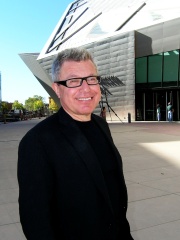
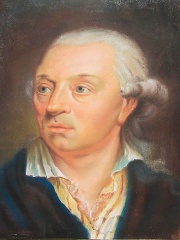
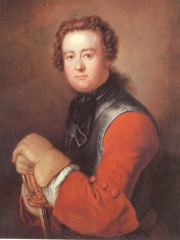
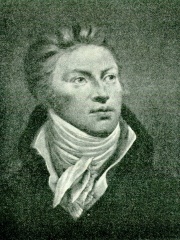
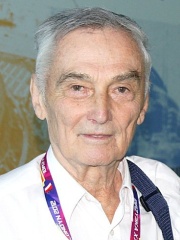
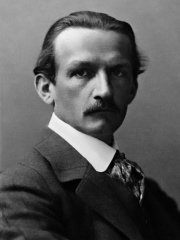
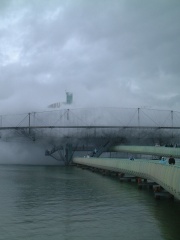
The Most Famous
ARCHITECTS from Poland
This page contains a list of the greatest Polish Architects. The pantheon dataset contains 518 Architects, 9 of which were born in Poland. This makes Poland the birth place of the 15th most number of Architects behind Denmark, and Czechia.
Top 9
The following people are considered by Pantheon to be the most legendary Polish Architects of all time. This list of famous Polish Architects is sorted by HPI (Historical Popularity Index), a metric that aggregates information on a biography's online popularity.

1. Erich Mendelsohn (1887 - 1953)
With an HPI of 69.40, Erich Mendelsohn is the most famous Polish Architect. His biography has been translated into 42 different languages on wikipedia.
Erich Mendelsohn (German pronunciation: [ˈeːʁɪç ˈmɛndl̩ˌzoːn] ); 21 March 1887 – 15 September 1953) was a German-British architect, known for his expressionist architecture in the 1920s, as well as for developing a dynamic functionalism in his projects for department stores and cinemas. Mendelsohn was a pioneer of the Art Deco and Streamline Moderne architecture, notably with his 1921 Mossehaus design.

2. Daniel Libeskind (b. 1946)
With an HPI of 68.69, Daniel Libeskind is the 2nd most famous Polish Architect. His biography has been translated into 38 different languages.
Daniel Libeskind (born May 12, 1946) is a Polish–American architect, artist, professor, and set designer. Libeskind founded Studio Daniel Libeskind in 1989 with his wife, Nina, and is its principal design architect. He is known for the design and completion of the Jewish Museum in Berlin, Germany, that opened in 2001. On February 27, 2003, Libeskind received further international attention after he won the competition to be the master plan architect for the reconstruction of the World Trade Center site in Lower Manhattan. Other buildings that he is known for include the extension to the Denver Art Museum in the United States, the Grand Canal Theatre in Dublin, the Imperial War Museum North in Greater Manchester, England, the Michael Lee-Chin Crystal at the Royal Ontario Museum in Toronto, Canada, the Felix Nussbaum Haus in Osnabrück, Germany, the Danish Jewish Museum in Copenhagen, Denmark, Reflections in Singapore and the Wohl Centre at the Bar-Ilan University in Ramat Gan, Israel. His portfolio also includes several residential projects. Libeskind's work has been exhibited in major museums and galleries around the world, including the Museum of Modern Art, the Bauhaus Archives, the Art Institute of Chicago, and the Centre Pompidou.

3. Carl Gotthard Langhans (1732 - 1808)
With an HPI of 66.54, Carl Gotthard Langhans is the 3rd most famous Polish Architect. His biography has been translated into 28 different languages.
Carl Gotthard Langhans (15 December 1732 – 1 October 1808) was a Prussian master builder and royal architect. His churches, palaces, grand houses, interiors, city gates and theatres in Silesia, Berlin, Potsdam and elsewhere belong to the earliest examples of Neoclassical architecture in Germany. His best-known work is the Brandenburg Gate in Berlin, national symbol of today’s Germany and German reunification in 1989/90.

4. Georg Wenzeslaus von Knobelsdorff (1699 - 1753)
With an HPI of 64.74, Georg Wenzeslaus von Knobelsdorff is the 4th most famous Polish Architect. His biography has been translated into 29 different languages.
(Hans) Georg Wenzeslaus von Knobelsdorff (17 February 1699 – 16 September 1753) was a painter and architect in Prussia. Knobelsdorff was born in Kuckädel, now in Krosno Odrzańskie County. A soldier in the service of Prussia, he resigned his commission in 1729 as captain so that he could pursue his interest in architecture. In 1740 he travelled to Paris and Italy to study at the expense of the new king, Frederick II of Prussia. Knobelsdorff was influenced as an architect by French Baroque Classicism and by Palladian architecture. With his interior design and the backing of the king, he created the basis for the Frederician Rococo style at Rheinsberg, which was the residence of the crown prince and later monarch. Knobelsdorff was the head custodian of royal buildings and head of a privy council on financial matters. In 1746 he was dismissed by the king, and Johann Boumann finished all his projects, including Sanssouci. Knobelsdorff died in Berlin. His grave is preserved in the Protestant Friedhof I der Jerusalems- und Neuen Kirchengemeinde (Cemetery No. I of the congregations of Jerusalem's Church and New Church) in Berlin-Kreuzberg, south of Hallesches Tor. Karl Begas the younger created a statue of Knobelsdorff in 1886. This originally stood in the entrance hall of the Altes Museum (in Berlin) and is now in a depot of the state museum.
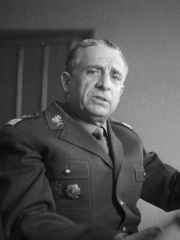
5. Marian Spychalski (1906 - 1980)
With an HPI of 60.72, Marian Spychalski is the 5th most famous Polish Architect. His biography has been translated into 24 different languages.
Marian "Marek" Spychalski (pronounced [ˈmarjan spɨˈxalskʲi], 6 December 1906 – 7 June 1980) was a Polish architect in pre-war Poland, and later, military commander and a communist politician. During World War II he belonged to the Polish underground forces operating within Poland and was one of the leaders of the People's Guard, then People's Army. He held several key political posts during the PRL era, most notably; Chairman of the Council of State, mayor of Warsaw and Defence Minister.

6. Friedrich Gilly (1772 - 1800)
With an HPI of 59.81, Friedrich Gilly is the 6th most famous Polish Architect. His biography has been translated into 18 different languages.
Friedrich David Gilly (16 February 1772 – 3 August 1800) was a German architect and the son of the architect David Gilly. His works are influenced by revolutionary architecture (Revolutionsarchitektur). Born in Altdamm, Pomerania, (today Dąbie, district of Szczecin, Poland), Gilly was known as a prodigy and the teacher of the young Karl Friedrich Schinkel. In 1788 he enrolled at the Akademie der Bildenden Künste in Berlin. His teachers in architecture were Friedrich Becherer and Carl Gotthard Langhans. Gilly enjoyed drawing lessons with Christian Bernhard Rode, Johann Christoph Frisch, Johann Heinrich Meil, Daniel Nikolaus Chodowiecki and Johann Gottfried Schadow. In the practical part, he was taught by Carl Gotthard Langhans, Michael Philipp Boumann and Baron Friedrich Wilhelm von Erdmannsdorff. He was first employed by the Oberhofbauamt in 1789, and worked for a time with Bernhard Matthias Brasch on the reconstruction of Neuruppin. In 1797, Gilly travelled extensively in France, England, and Austria. The drawings he made in France reveal his interests in architecture and reflect the intellectual climate of the Directoire. They include views of the Fountain of Regeneration, the Rue des Colonnes—an arcaded street of baseless Doric columns leading to the Théâtre Feydeau—the chamber of the Conseil des Anciens in the Tuileries and Jean-Jacques Rousseau’s grotto in its landscaped setting at Ermenonville, Oise. His 1797, design for the Frederick II monument reveals his debt to French neoclassicism, in particular Etienne-Louis Boullée. His explanatory notes indicate that he intended the building to be spiritually uplifting. The plan for the monument is currently part of the collection of the Kupferstichkabinett in Berlin. From 1799, Schinkel lived in the Gilly household at Berlin and was taught by Friedrich and Friedrich's architect father David Gilly. Gilly was appointed professor at the Berlin Bauakademie at the age of 26. Of his built designs, only one survives: the ruinous Greek Revival mausoleum (1800–02; destroyed after 1945) at Dyhernfurth near Breslau (now Brzeg Dolny near Wrocław, Poland), in the form of a prostyle Greek temple. Gilly died from tuberculosis at the age of 28 in Karlsbad, where he was buried in the cemetery of Andreaskapelle.

7. Wojciech Zabłocki (1930 - 2020)
With an HPI of 58.95, Wojciech Zabłocki is the 7th most famous Polish Architect. His biography has been translated into 20 different languages.
Wojciech Mikołaj Zabłocki (6 December 1930 – 5 December 2020) was a Polish architect and fencer, specialist in the saber modality.

8. Max Berg (1870 - 1947)
With an HPI of 57.95, Max Berg is the 8th most famous Polish Architect. His biography has been translated into 18 different languages.
Max Berg (17 April 1870 – 22 January 1947) was a German architect and urban planner.

9. Elizabeth Diller (b. 1958)
With an HPI of 46.92, Elizabeth Diller is the 9th most famous Polish Architect. Her biography has been translated into 17 different languages.
Elizabeth Diller, also known as Liz Diller, is an American architect and partner in Diller Scofidio + Renfro, which she co-founded in 1981. She is also an architecture professor at Princeton University.
People
Pantheon has 9 people classified as Polish architects born between 1699 and 1958. Of these 9, 2 (22.22%) of them are still alive today. The most famous living Polish architects include Daniel Libeskind, and Elizabeth Diller. The most famous deceased Polish architects include Erich Mendelsohn, Carl Gotthard Langhans, and Georg Wenzeslaus von Knobelsdorff.
Living Polish Architects
Go to all RankingsDeceased Polish Architects
Go to all RankingsErich Mendelsohn
1887 - 1953
HPI: 69.40
Carl Gotthard Langhans
1732 - 1808
HPI: 66.54
Georg Wenzeslaus von Knobelsdorff
1699 - 1753
HPI: 64.74
Marian Spychalski
1906 - 1980
HPI: 60.72
Friedrich Gilly
1772 - 1800
HPI: 59.81
Wojciech Zabłocki
1930 - 2020
HPI: 58.95
Max Berg
1870 - 1947
HPI: 57.95
Overlapping Lives
Which Architects were alive at the same time? This visualization shows the lifespans of the 6 most globally memorable Architects since 1700.

